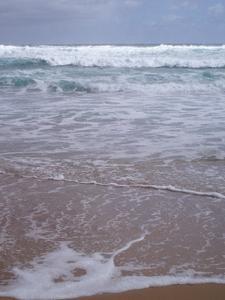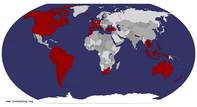Advertisement
Published: December 12th 2006

 Up Close
Up Close
The Great Southern Ocean from the beach at the Gibson Steps, where treacherous stone steps lead right down the cliffs to the beach and the absolutely freezing cold water !To the thousands of immigrants arriving in Australia two hundred years ago, the coastline we are driving along today would have been the first land in sight after many months of sailing in cramped and uncomfortable conditions. So far from home, the sight of the Victorian coast must have come as a huge relief, but the danger was far from over.
South of here, not a speck of land separates Australia from Antarctica. Nothing to stand in the way of the wind and the waves. Stepping out of the campervan on our first stop along the coast, we suddenly understand why these latitudes are known as the "roaring forties" - the wind ! The road from Cape Otway has risen and we are now driving along steep cliffs. The vicious south-westerly wind whips the freezing waters below into a unbelievable frenzy - and boy can we feel it too. Driving a higher sided vehicle than I'm used to, the powerful gusts of wind slam into the side of the campervan, which becomes surprisingly difficult to control.
The Shipwreck Coast between Lorne and Port Campbell is a deadly stretch of coastline. Few or no natural harbours, hidden reefs and the

 Razor sharp
Razor sharp
The jagged coastline of south-western Victoria, seen from the Gibson Steps. Erosion in action !appalling weather conditions for much of the year have conspired to send many a ship to a watery grave. Indeed, our map of the coast around this area is alarmingly liberally dotted with the "shipwreck" symbol. Numerous lighthouses were built along the coast, a particularly important one on Cape Otway, in an attempt to warn arriving ships of the hazardous reefs. Despite this, wrecks were still extremely frequent.
There is a wealth of fascinating places to stop at along this section of coast: two which struck us in particular (albeit for very different reasons) were the famous Twelve Apostles and Loch Ard Gorge. The first is a short stretch of particularly scenic coastline where the action of the wind and sea has created a number of offshore pinnacles, tall columns of sedimentary rock which remained standing while the stone around them collapsed into the sea over hundreds of thousands of years. These pinnacles, which at some point numbered twelve (I don't think there are twelve still standing...) were named the Twelve Apostles - very imaginative - and are quite a sight, surrounded as they are by churning seas and lashing waves. Huge waves the likes of which I have

 Simon, Andrew, Thomas and friends
Simon, Andrew, Thomas and friends
A view of (some of) the Twelve Apostles from a cliff promontory. Good thing you can't hear the yabbering tourists clamouring for the best photo !never seen throw themselves head on against the pinnacles and the cliffs, throwing great plumes of spray tens of metres into the air. My breath catches in my throat - it's not only the fact that the gale force winds are blowing directly into our faces...I have simply never seen the sea so explicitly violent, so dangerous and so close. The waves are immense, and the mere thought of being on a sail-powered wooden vessel in those seas fills me with dread. It is utterly incredible. Despite the cold and the wind, we remain on the boardwalks overlooking the precipitous cliffs, transfixed by the raging water.
This is nature at its most wild. It is also very accessible from the Great Ocean Road, which has lead to the Twelve Apostles being touted as a prime destination for tour buses from Melbourne. A immense car park has been built across the road and a tunnel passes under the road towards a boardwalk that runs along the top of the cliff and even out onto a promontory from which you can get a good look at the coast for miles east and west. The place is teeming with visitors on one-day

 Menacing skies...
Menacing skies...
...over the Great Southern Ocean. Roaring waves and howling wind complete the picture.trips from Melbourne - the roaring of the ocean is all but drowned out by the shouting of huge tour groups and the view somewhat spoiled by large groups of tourists posing for photographs (complete with V-signs - I shall refrain from any further description but I'm sure you get the idea). Appreciation of the awe-inspiring view appears to be lacking.
The strange thing is how the Twelve Apostles have been hyped up into a "must see" destination while the countless other fascinating spots along the Shipwreck Coasts are all but forgotten. Loch Ard Gorge, for instance, just a few miles west of the Apostles. The gorge is named after the
Loch Ard, a clipper that had travelled for three months from London, en route to Melbourne, when it approached the southern Victorian coast in June 1878. A celebratory dinner was underway aboard the ship as the long, soul-destroying journey from England was about to end. The ship was shrouded with heavy fog, obscuring the light from nearby Cape Otway Lighthouse. In the morning the fog lifted for the captain to find himself nearly face to face with the towering cliffs. He tried to navigate the
Loch Ard away

 Thunder Bay
Thunder Bay
Narrow entrance to Thunder Bay, where huge waves force the ocean through the gap into the bay. The sea level within the bay varies by several metres between each wave !from the cliffs only to find himself blown closer to the cliffs in towering waves. As the crew desperately tried to save their ship, their passengers and themselves, the sails were lowered then raised again, the anchor dropped, weighed, dropped then cut. Just when the clipper seemed to be on the verge of escaping the razor-sharp cliff faces it became impaled on a sunken, uncharted reef. She sank in a matter of minutes, taking with her 52 out of her 54 passengers. The two survivors, a young lady named Eva Carmichael and Tom Pearce, a lowly member of the crew, clung for hours to wreckage before being washed ashore on a beach surrounded by tall cliffs. Tom managed to climb out and was fortunate to happen upon two settlers who were able to rescue Eva from the gorge and provide both survivors with shelter, food and (of course) brandy. Eva had been travelling with several family members, all of which drowned with the clipper slipped beneath the waves. On the day of our visit, the story of the wrecking of the
Loch Ard comes as no surprise. Here the sea is even more ferocious, the waves higher, the roar truly

 And into the Blowhole...
And into the Blowhole...
After a sharp turn right, the huge volumes of water are forced through the entrance to the Blowhole. As the air is forced out by the water a huge bellow can be heard.deafening. A few hundred metres west of the gorge where Eva and Tom were washed ashore is a deep indentation in the cliffs known as Thunder Bay. A narrow channel a hundred or so metres long and perhaps fifteen metres wide carries the ocean inland, where the channel abruptly makes a ninety degree turn and tunnels into the rock, disappearing out of sight. A little further down this tunnel, the roof has collapsed, producing an open blowhole directly (but invisibly) connected to the ocean. It is an extraordinary example of the ocean's erosive power. To the rhythm of the waves, water tears down the channel, its surface nothing but foam, makes the turn with a immense crash and thunders into the blowhole where it meets solid rock and is thrown high into the air with a thunderous bang. It is possible to step down close to water just where Thunder Bay makes its turn, down a steep flight of steps carved directly into the rock face and wet with spray. The sight which greeted us there was so powerful as to take, once again, our breath away. On occasion, a particularly large wave would enter the channel, raising the water

 Private Beach !
Private Beach !
But how to get to it ? A beautiful beach on the tiny Muttonbird Island off the coast, a refuge to thousands of the eponymous birds.level by many metres. As the water was sucked out again with tremendous force, huge expanses of rock covered in kelp would be bared, hundreds of thousands of litres of sea pouring off the stepped cliff faces. It was absolutely heart-stopping. For once we were glad for the grey skies and lashing winds, for on a calm day this place would have paled in comparison with what we witnessed. More steps lead down to Loch Ard Gorge itself, a beautiful deep gorge with a sandy beach and the blind end of which was gouged by the sea, producing deep caves hanging with stalactites. The enclosed shape of the gorge itself helped calm the sea, and it took but a small step of the imagination to picture Tom and Eva washed up here just 128 years ago. My photos do a poor job of hinting at just how wild this place is - it cannot be believed unless it is seen.
Another extraordinary stop is at the amusingly named London Bridge. Now a small island just offshore, it was until sixteen years ago connected to the mainland by an arch of rock that was a popular attraction along the Great

 Victims of the Loch Ard
Victims of the Loch Ard
Hidden in the windswept, salt-scarred bush on the cliffs overlooking the gorge, a small cemetery where the bodies recovered from the wreck of the Loch Ard lie. Whole families are buried here.Ocean Road. Suddenly, on 15th January 1990, the arch abruptly collapsed without warning into the sea, suddenly turning London Bridge into an island. Most extraordinary of all - at the time of the collapse two hapless tourists happened to be standing on the outer part of the outcrop ! The sudden disintegration of the arch left them stranded on the new island, and the two were rather miraculously rescued by helicopter...it beggars belief ! Talk about lucky - a few dozen metres inland and they would have joined hundreds of tons of rock tumbling down to the sea.
Loch Ard Gorge, London Bridge, and other amazing spots like the Gibson Steps which lead right down to the sea - all are deserted. Somehow the sheer power of nature was immeasurably intensified by the feeling of solitude. No tour buses here. Yet five or so kilometres down the road...strange. A good reason to avoid bus tours if ever there was one. Not that we needed to be discouraged...
Drunk on fresh sea air and giddy from the awe-inspiring views, we pull into Port Campbell, a low-key but charming township further west. This is one of the handful of safe

 Shipwrecked !
Shipwrecked !
The isolated beach where the two survivors of the wreck were washed ashore.harbours along the southern Victoria coast - even then, the sea, metres away from the campsite, can still be heard, angry and dangerous as ever. "No swimming", says the sign on the beach.
You don't say.
Advertisement
Tot: 0.115s; Tpl: 0.015s; cc: 6; qc: 30; dbt: 0.069s; 1; m:domysql w:travelblog (10.17.0.13); sld: 1;
; mem: 1.1mb

















